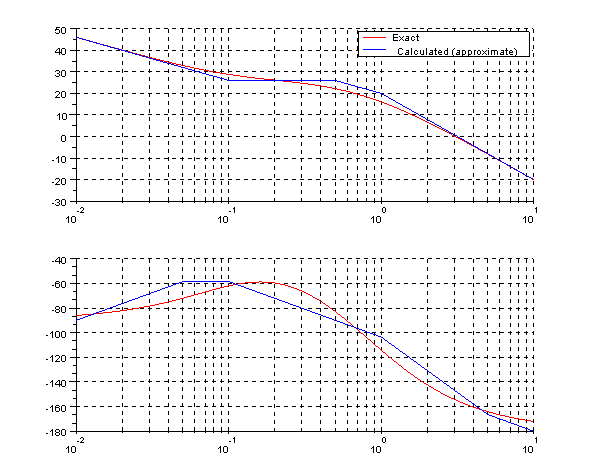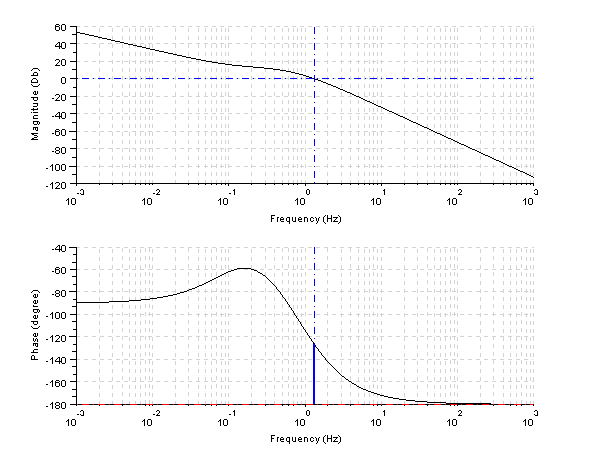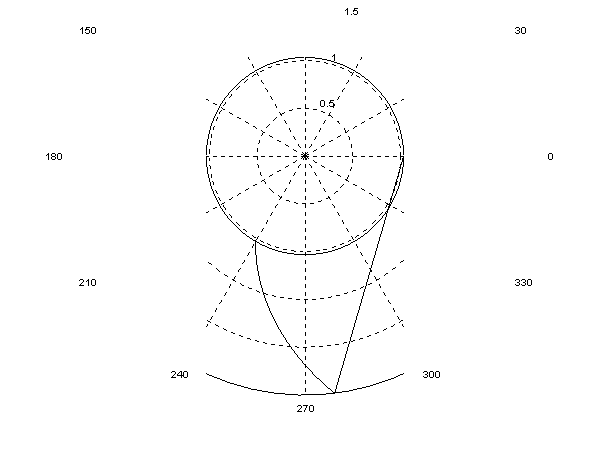We want the phase margin equal to 60. Let's calculate K.
Solution:
Let's calculate the system's Bode plot.
Gain table:
| w |
|
0.1 |
|
0.5 |
|
1 |
|
 |
(0) |
0 |
(20) |
|
( 20) |
|
(20) |
 |
(0) |
0 |
(0) |
0 |
(-20) |
|
(-20) |
 |
(-20) |
|
(-20) |
|
(-20) |
0 |
(-20) |
 |
(0) |
0 |
(0) |
0 |
(0) |
0 |
(-20) |
 |
(-20) |
26 |
(0) |
26 |
(-20) |
20 |
(-40) |
Phase table:
| w |
|
0.01 |
|
0.05 |
|
0.1 |
|
0.5 |
|
1 |
|
5 |
|
10 |
 |
(0) |
0 |
(45) |
|
(45) |
45 |
(45) |
|
(45) |
90 |
(0) |
90 |
(0) |
90 |
 |
(0) |
0 |
(0) |
0 |
(-45) |
|
(-45) |
-45 |
(-45) |
|
(-45) |
-90 |
(0) |
-90 |
 |
(0) |
-90 |
(0) |
-90 |
(0) |
-90 |
(0) |
-90 |
(0) |
-90 |
(0) |
-90 |
(0) |
-90 |
 |
(0) |
0 |
(0) |
0 |
(0) |
0 |
(-45) |
|
(-45) |
-45 |
(-45) |
|
(-45) |
-90 |
 |
(0) |
-90 |
(45) |
-58 |
(0) |
-58 |
(-45) |
-90 |
(-45) |
-103 |
(-90) |
-166 |
(-45) |
-180 |
Calculations and checks by Scilab
w1=[0.01 0.1 0.5 1 10];
w2=[0.01 0.05 0.1 0.5 1 5 10];
gdb1=20*log10(10*0.1/0.5)
gdb(1)=gdb1-20*log10(0.01)
gdb(2)=gdb1-20*log10(0.1)
gdb(3)=gdb(2)
gdb(4)=gdb(3)-20*log10(1/0.5)
gdb(5)=gdb(4)-40*log10(10)
a(1)=-90
a(2)=a(1)+45*log10(0.05/0.01)
a(3)=a(2)
a(4)=a(3)-45*log10(0.5/0.1)
a(5)=a(3)-45*log10(1/0.1)
a(6)=a(5)-90*log10(5/1)
a(7)=-180
s=%s/(2*%pi);
g=10*(s+0.1)/((s+0.5)*s*(s+1));
gs=syslin('c',g);
w=logspace(-2,1,100);
gsf=tf2ss(gs);
[frq1,rep] =repfreq(gsf,w);
[db,phi]=dbphi(rep);
clf;
subplot(2,1,1);
plot2d(w,db,5,logflag="ln")
plot2d(w1,gdb,2,logflag="ln")
legends(['Exact','Calculated (approximate)'],[5,2],opt=1);
xgrid;
subplot(2,1,2);
plot2d(w,phi,5,logflag="ln")
plot2d(w2,a,2,logflag="ln")
xgrid;

Let us calculate the phase at which that phase margin occurs . We will add 5 degrees to compensate for the approximation of the Bode plot with the tables.
When the function's phase

is equal to -108, that frequency is the gain crossover frequency.
Now let's calculate the gain

in the new crossover frequency.
With this value, we calculate the value of K:
Checks by Scilab
gdb1=20*log10(10*0.1/0.5)
gdb(1)=gdb1-20*log10(0.01)
gdb(2)=gdb1-20*log10(0.1)
gdb(3)=gdb(2)
gdb(4)=gdb(3)-20*log10(1/0.5)
gdb(5)=gdb(4)-40*log10(10)
a(1)=-90
a(2)=a(1)+45*log10(0.05/0.01)
a(3)=a(2)
a(4)=a(3)-45*log10(0.5/0.1)
a(5)=a(3)-45*log10(1/0.1)
a(6)=a(5)-90*log10(5/1)
a(7)=-180
nf=-180+60
nwcg=10^((-nf+a(5))/90)
gdbnwcg=gdb(4)-40*log10(nwcg)
k=10^(-gdbnwcg/20)
s=%s/(2*%pi);
g=k*10*(s+0.1)/((s+0.5)*(s+0.0000000001)*(s+1));
gs=syslin('c',g);
[mf,fcg]=p_margin(gs)
clf;
show_margins(gs);
Results:
fcg =
1.1035521
mf =
61.378401
As see, exist a little gain error by the approximation with respect to book

Let's do the program 9.4
Scilab program:
s=%s;
g=10*(s+0.1)/((s+0.5)*s*(s+1));
w=0.5:0.01:1.15;
gs=syslin('c',0.13*g);
gs2=syslin('c',0.188*g);
gr=horner(gs,%i*w);
gr2=horner(gs2,%i*w);
theta=atan(imag(gr),real(gr));
theta2=atan(imag(gr2),real(gr2));
ro=abs(gr);
ro2=abs(gr2);
clf;
k=0:0.01:2*%pi;
nr=cos(k)+%i*sin(k);
theta3=atan(sin(k),cos(k));
ro3=abs(nr);
polarplot([theta3 theta2],[ro3 ro2]);
